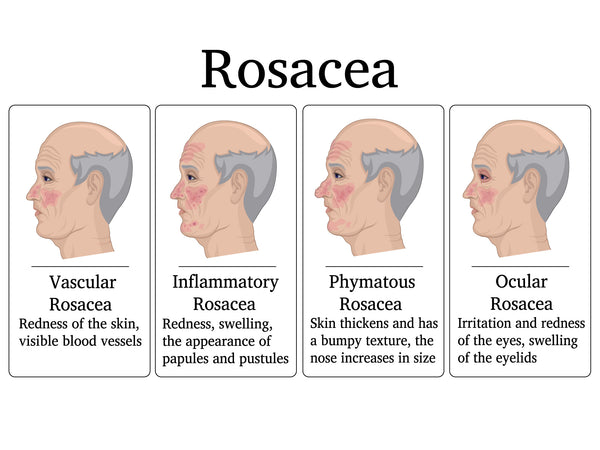You might think that rosacea was rosacea, and that was that… but in fact there are four separate subtypes of the condition.
All four variations present slightly differently and require different management strategies; they can also resemble other skin conditions which would also need different treatments, so it’s definitely worth knowing which is which!
All different rosacea subtypes have the same general characteristics: the skin affected is on the face, particularly on the middle zone of nose, cheeks and chin, but sometimes affecting the forehead and eyes as well. All types of rosacea are more prevalent in people from English, Irish, Scottish and Scandinavian ethnic backgrounds; people who blush easily and have red hair are especially likely to suffer from rosacea.
In general, women are more prone to rosacea, but when men do develop rosacea they’re likely to have more severe symptoms.

The four different types of rosacea
SUBTYPE 1: Erythematotelangiectatic rosacea (ETR) aka vascular rosacea
This is the most common type of rosacea, and what most people think of when they hear the term. It’s characterised by redness*, inflammation, tiny visible veins on the nose and cheeks, feeling hot, tight or itchy, and the appearance of flushing or blushing.
SUBTYPE 2: Papulopustular rosacea aka inflammatory rosacea
This subtype can be confused with acne; in fact, it’s often called ‘acne rosacea’ because it manifests as bumps, pimples and rashes that can look very much like acne. However, the two conditions are different in origin, and need to be treated differently. Check out our article What is Acne Rosacea? for more information about the condition.
SUBTYPE 3: Phymatous rosacea
Phymatous rosacea is rarer than ETR, and, unusually for rosacea, more prevalent in men than women. It affects the nose, and can result in a reddened, bumpy, enlarged or bulbous nose. The thickened skin on the nose results in a condition known as rhinophyma.
SUBTYPE 4: Ocular rosacea
The type of rosacea affects the eyes, and can cause permanent damage if not treated. The eyes can get very dry, irritated and gritty; they can look red, watery and bloodshot, and feel very uncomfortable. There can be bumps on the eyelids, and the condition can even affect the cornea if left untreated.
*While rosacea is most common in people of Irish, English, Scottish and Scandinavian ethnicities, it does occasionally occur in people of BAME backgrounds too, in which case, it would more likely appear as bumps, pustules and a sensation of heat rather than the visible flushing on paler skin.
If you suspect you have any variation of rosacea, it’s important to get a diagnosis and work out a treatment plan, both to rule out anything else and to keep the condition from getting worse and leaving permanent damage.
But there are things you can do to help yourself manage your rosacea flares! Check out our article on Rosacea Awareness Month for more information on the condition.
Recommended products for skin prone to rosacea:
Balmonds Daily Moisturising Cream with shea butter, calendula and hemp (from £13.99 for 100ml): a nourishing but non-comedogenic daily moisturiser, for use anywhere on the body, face and hands.
Balmonds Cooling Cream with shea, menthol, aloe vera & lavender (£19 for 100ml); a light lotion designed to take the heat out of flushed skin.
Balmonds Intensive Facial Oil with rosehip, calendula, lavender & chamomile (£22 for 30ml): a rich, regenerative oil to help balance and restore sensitive skin.

